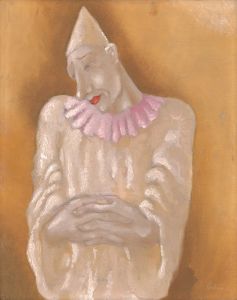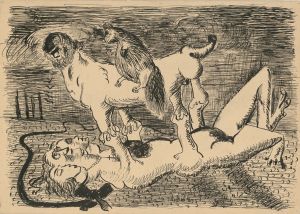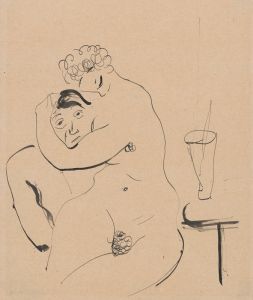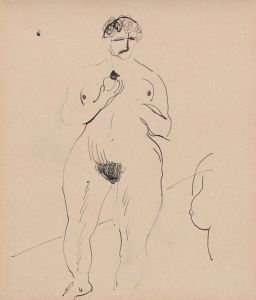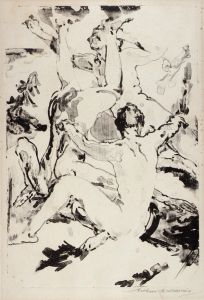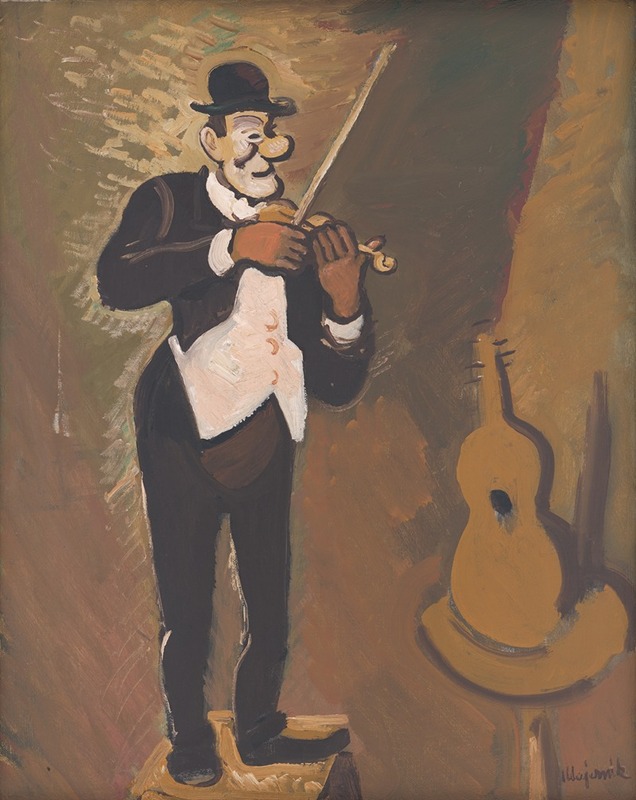
Clown Playing the Violin
A hand-painted replica of Cyprián Majerník’s masterpiece Clown Playing the Violin, meticulously crafted by professional artists to capture the true essence of the original. Each piece is created with museum-quality canvas and rare mineral pigments, carefully painted by experienced artists with delicate brushstrokes and rich, layered colors to perfectly recreate the texture of the original artwork. Unlike machine-printed reproductions, this hand-painted version brings the painting to life, infused with the artist’s emotions and skill in every stroke. Whether for personal collection or home decoration, it instantly elevates the artistic atmosphere of any space.
Cyprián Majerník was a Slovak painter known for his poignant and expressive works, often reflecting the socio-political turmoil of his time. One of his notable paintings is "Clown Playing the Violin," which encapsulates his unique style and thematic concerns. Majerník was born on November 24, 1909, in Veľké Kostoľany, then part of the Austro-Hungarian Empire, and he later became an influential figure in Slovak art during the early to mid-20th century.
"Clown Playing the Violin" is a striking example of Majerník's ability to convey deep emotion and narrative through his art. The painting features a clown, a recurring motif in Majerník's work, playing a violin. This imagery is often interpreted as a symbol of the artist's commentary on the human condition, reflecting themes of melancholy, irony, and the juxtaposition of joy and sorrow. The clown, traditionally a figure of entertainment and laughter, is depicted in a more somber light, suggesting a deeper, perhaps more tragic, narrative beneath the surface.
Majerník's use of color and form in this painting is notable. He employs a muted palette, which enhances the emotional weight of the scene. The brushwork is expressive, capturing the tension and emotion of the moment. The clown's posture and facial expression are rendered with a sensitivity that invites viewers to ponder the story behind the image. This approach is characteristic of Majerník's broader body of work, which often explores themes of existential struggle and the absurdity of life.
The historical context of Majerník's life and work is essential to understanding "Clown Playing the Violin." Living through the interwar period and the rise of totalitarian regimes in Europe, Majerník's art was inevitably influenced by the political and social upheavals of his time. His paintings often reflect a sense of disillusionment and critique of the world around him. The clown, in this context, can be seen as a metaphor for the artist himself or for humanity at large, grappling with the absurdities and tragedies of life.
Majerník studied at the Academy of Fine Arts in Prague, where he was exposed to various artistic movements and ideas that shaped his style. His work is often associated with Expressionism, a movement characterized by its focus on representing emotional experiences rather than physical reality. This influence is evident in "Clown Playing the Violin," where the emotional resonance of the image takes precedence over realistic depiction.
Throughout his career, Majerník remained committed to exploring complex themes through his art. Despite facing personal challenges, including a battle with multiple sclerosis, he continued to produce impactful work until his untimely death in 1945. "Clown Playing the Violin" stands as a testament to his artistic vision and his ability to capture the multifaceted nature of human experience.
In summary, "Clown Playing the Violin" by Cyprián Majerník is a powerful piece that reflects the artist's engagement with themes of irony, melancholy, and the human condition. Through his expressive use of color and form, Majerník invites viewers to contemplate the deeper narratives within his work, making it a significant contribution to Slovak and European art.





